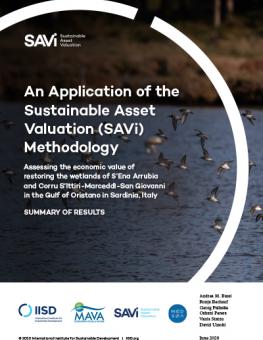
An Application of the Sustainable Asset Valuation (SAVi) Methodology: Assessing the economic value of restoring the wetlands of S'Ena Arrubia and Corru S'Ittiri-Marceddì-San Giovanni in the Gulf of Oristano in Sardinia, Italy
An application of the Sustainable Asset Valuation (SAVi) methodology
This assessment uses the Sustainable Asset Valuation (SAVi) to calculate the economic and societal value generated by the S’Ena Arrubia and Corru S’Ittiri-Marceddì-San Giovanni wetlands in the Gulf of Oristano in Sardinia, Italy.
Key Messages
- S’Ena Arrubia and Corru S’Ittiri-Marceddì-San Giovanni lagoons in Sardinia will generate cumulative ecosystem services worth EUR 306 million between 2020 and 2060. If there is no degradation in wetland quality, an additional value of EUR 171 million could be captured over 40 years.
- After adjusting for the cost of production facilities, the circular business scenario of reusing livestock manure generates a net benefit of EUR 81.3 million in S’Ena Arrubia and EUR 124.2 million in Corru S’Ittiri-Marceddì-San Giovanni.
This assessment uses the Sustainable Asset Valuation (SAVi) to calculate the economic and societal value generated by the S’Ena Arrubia and Corru S’Ittiri-Marceddì-San Giovanni wetlands in the Gulf of Oristano in Sardinia, Italy. They are protected by the Ramsar Convention, an international treaty for the conservation and sustainable use of wetlands. The two sites are important biodiversity reservoirs due to the presence of numerous plant and animal species, and they provide essential ecosystem services. They enable a range of local industries, including agriculture, tourism, fisheries, and aquaculture.
This SAVi assessment covers the following topics:
- The dollar value of the ecosystem services provided by the S’Ena Arrubia and Corru S’Ittiri-Marceddì-San Giovanni wetlands.
- The dollar value of the labour income generated by tourism, fisheries, and agriculture that is enabled and enhanced by the wetland sites.
- Capital and operating costs of built infrastructure that will provide the same output of services. This is important to enable stakeholders to compare and contrast natural capital with built assets.
- The financial feasibility of circular economy solutions in the reuse of agricultural waste.
- The possibility of re-targeting direct income support in the agriculture sector toward better environmental performance.
Participating experts
You might also be interested in
A Sustainable Asset Valuation of Non-Motorized Transport in Coimbatore, India
A Sustainable Asset Valuation (SAVi) of the economic, social, and environmental benefits of a non-motorized transport (NMT) network in Coimbatore, India.
Sustainable Asset Valuation of the Kalivaç and Poçem Hydropower Projects
The SAVi results suggest that the hydropower assets cannot be considered a preferable solution to generate electricity for the Albanian people.
Sustainable Asset Valuation (SAVi) of Senegal’s Saloum Delta
The assessment provides an economic valuation of the contribution of the Saloum Delta to local livelihoods and regional development.
Sustainable Asset Valuation (SAVi) of a Public Bicycle Sharing System in Dwarka, New Delhi, India: A focus on the environmental, social and economic impacts of non-motorized transport infrastructure
This SAVi assessment values the environmental, social and economic benefits generated by a public bicycle sharing system. Its results demonstrate how the transport system delivers to sustainable mobility targets in Delhi.